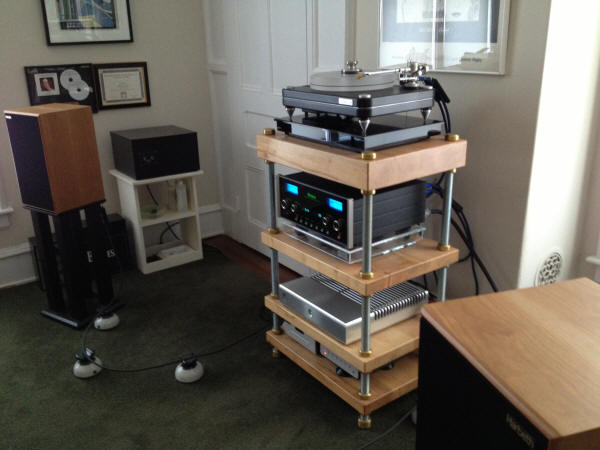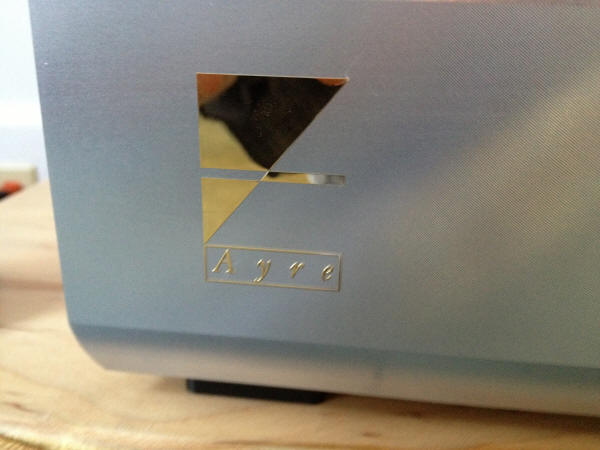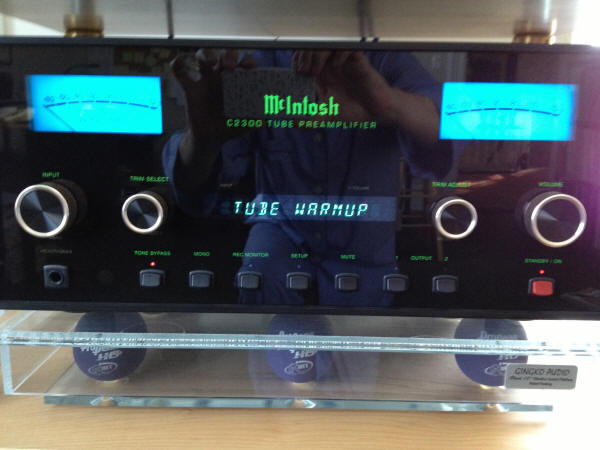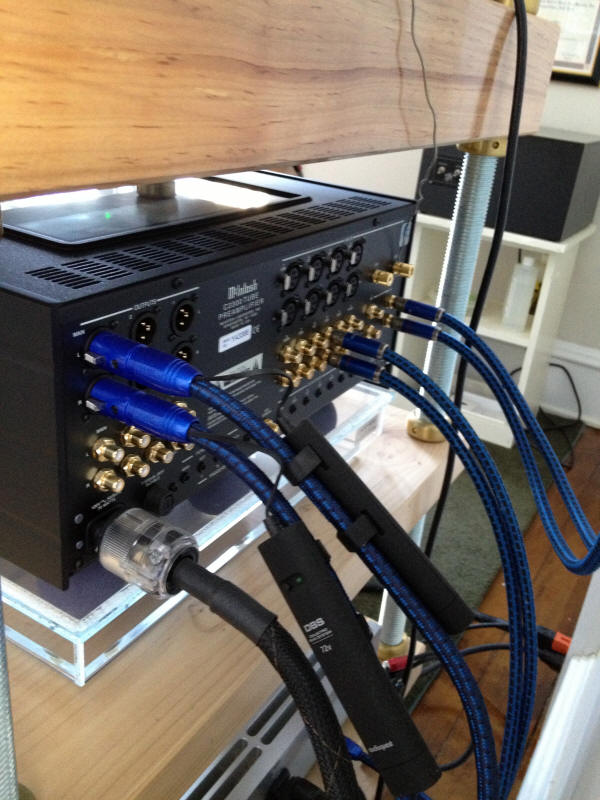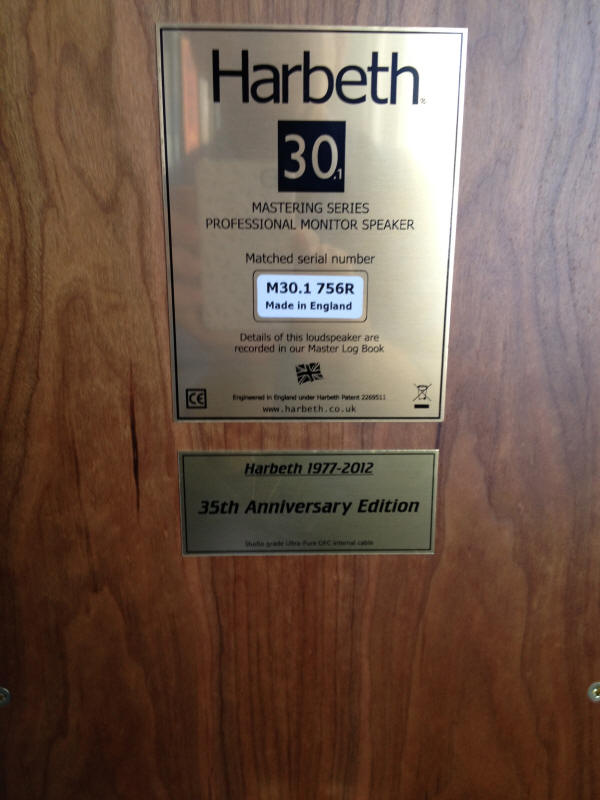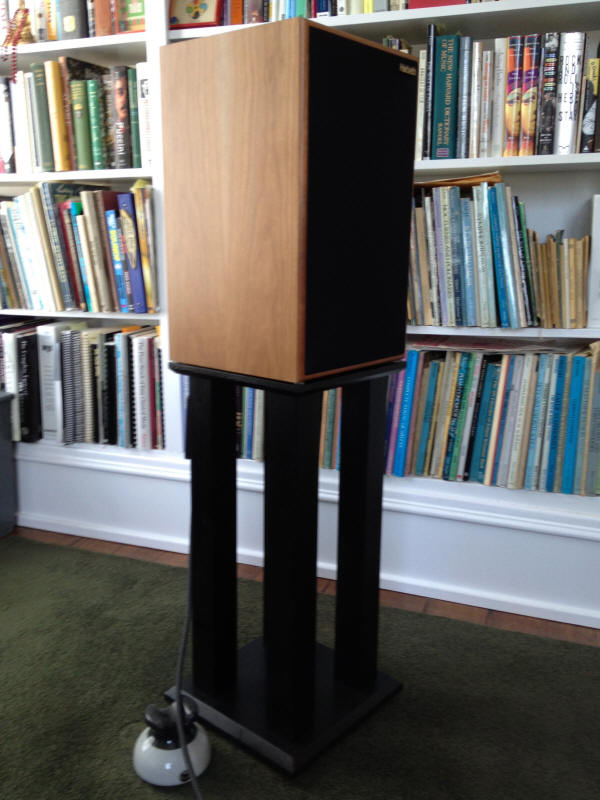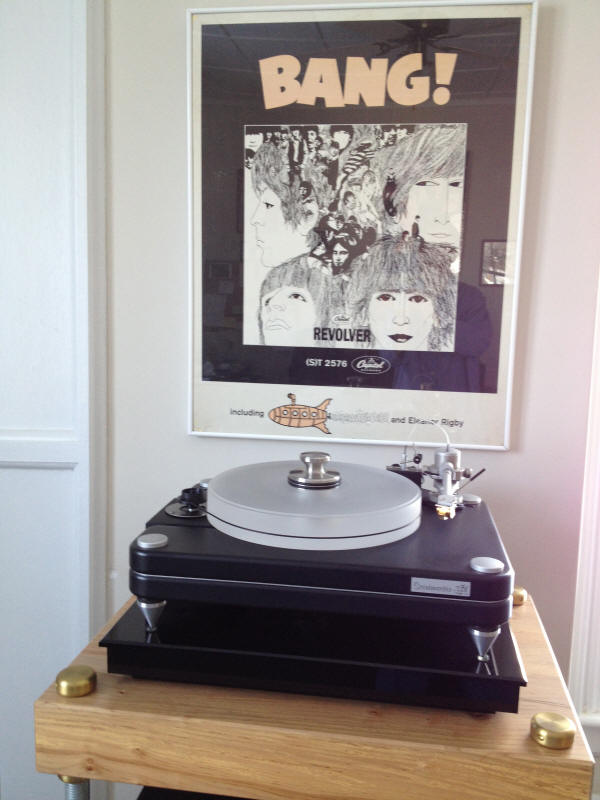You are reading the older HTML site
Positive Feedback ISSUE 72
Downsizing While Upscaling: Ayre VX-R, McIntosh
C2300, Harbeth 30.1
Less is More or Less? Necessity is the mother of invention. Planning for a move from my current country mouse lifestyle in up-state New York, (i.e. old large Victorian high ceiling dedicated listening room), to the ultimate city mouse experience, (small Manhattan apartment with multi-purpose rooms), created a logistical and musical challenge that I decided to get on top of in advance. I have moved in my life perhaps more than some, but I am sure that most of you reading this have experienced changes in your hi-fi music playback that track along with basic living architecture. I have not yet had the pleasure of building a dedicated listening room from the ground up. In my current listening room, mono-blocks on the floor are not an issue. Floor-standing speakers are not an issue. Separate dedicated components occupying individual rack shelves are not an issue. But planning ahead, the question became—what if they were? And if so, how could I maintain or perhaps surpass the level of musical quality I had carefully assembled over time, while simultaneously occupying less space? Here is the one-rack solution that I have come up with, that involved changing a number of components.
Ayre VX-R Stereo Amplifier 'Hopefully life is long, and there is room for more than one chapter.' I've often said this to friends and students. Yet we are all creatures of habit. Another way of putting this is 'never say never.' I purchased my first tubed amplifier in 1995, and ever since have been a member of that political hi-fi party. Yet as anyone into high-end audio knows, that tired old debate of solid-state versus tubes has really disappeared in recent years. Hearing is believing though, and my views really changed after spending a little time listening to a colleague's system being driven by Ayre MX-R mono-block amps. That got my attention all right, and I later filed it away in the category of 'unobtanium.' Ayre Acoustics, helmed by brilliant designer Charles Hansen, has long marked their territory at the very highest end of solid-state electronics. The Ayre MX-R mono-blocks, carved out of chunks of solid aluminum, have garnered much critical praise—and rightly so. I think lesser known to the high-end audience though, is the more recently produced Ayre VX-R stereo amplifier. The MX-R's put out an immaculate 300 watts of state of the art solid-state juice. Charles Hansen has stated that he designed the single-chassis VX-R amp for people fitting my description—those looking for a single unit that would fit on a typical rack shelf. In so doing Hansen made efforts to keep all design parameters the same, except for a reduction of output wattage from 300 to 200. In other words, all measured behavior remains the same up to the VX-R's stated output of 200 watts. I don't know about you, but this is plenty! Especially considering my system goals of downsizing, where an ability to power the largest and hungriest speaker systems was not a priority. Aesthetically, the VX-R amp should go into the MOCA permanent collection. It is one of the simplest and most elegantly proportioned examples of hardware I have ever seen. And you pay a premium for that—machining an amplifier block out of solid aluminum is obviously a significant production cost. The VX-R weighs an imposing 80 pounds, yet the low profile makes it suitable for any sturdy rack or shelving. The top surface is carved with ribs that dissipate generated heat. The amount of heat is not extreme—less than the tube mono-blocks it replaced. I would not place this amp in an enclosed cupboard however, it needs some clearance. The minimalist design reflects the simple nature of the function; back of the unit includes a single pair of speaker outputs, a single pair of balanced inputs, and AC power. The interior, which is to say that portion carved out of the aluminum block for that purpose, houses all electronic hardware and software. Quite simply, the VX-R = the sum of its parts, which are the best available at this point in time. (Rather than list all that I refer you to Ayre's own web pages for additional tech info.) The front of the unit continues the overall very handsome subtly brushed aluminum, with a single illuminated power button in the middle that changes color based on function. The unit when connected to AC is in permanent standby mode, (40 watts), glowing green. When you push the button to power up, it changes to glowing blue. That's it. The only downside here is that I find maneuvering 80 pounds onto and off a rack shelf is a back-straining operation for a single person, I'm certainly not swapping it in and out all the time! Depending on setup, this amplifier would certainly merit its own floor-stand as well.
Making music? The Ayre VX-R stereo amplifier produces the most sophisticated and musically complete re-creation of music I have ever heard. Coupled to the other components I changed recently in this re-design, I am hearing music that sounds more realistic and full of life than I ever thought I would be able to achieve in my own personal audio setup. If you look on the web you can find some tech measurements on the VX-R. One that I find particularly interesting, is the 'damping factor' measurement, which is particularly stable and flat throughout the entire frequency spectrum. This parameter may in part explain a lack of any false resonances and overhang of any sort, contributing to incredibly precise micro-detailing and ability to process musical information—like the Sorting Hat at Hogwarts. As far as the macro dimension goes—look out! Spine-tingling dynamics, which never sound artificial or exaggerated, but rather reflect the ups and downs of real musical performances. Just so you know, I purchased the VX-R like any other consumer—trading away a lot of gear plus ponying up the cash; this was not a review unit and there was no 'industry pricing.' Is everything always perfect in the small bespoke audio world? No—the first VX-R unit shipped to me from Colorado never powered up. Turned out it was some logic circuit cable that had come loose via UPS. To Ayre's credit they immediately set to building me another one and promptly shipped it—this one has worked perfectly from day one. Is this amplifier a luxury? You bet! But some luxuries are worth it, and some are not. I agree with others who have written about this amplifier, that considering how amazing it is, the retail price is reasonable! Any number of outstanding high-end systems could be anchored by the Ayre VX-R.
McIntosh C2300 Tube Preamplifier Life is short. Don't you want to own a piece of McIntosh gear before it's all over? I know I did, but somehow it never happened until I focused on my downsizing project. Despite that I have known and dealt with Steve Rowell and his fine Audio Classics Ltd. for some years, based in Binghamton, New York, where McIntosh has been made since time immemorial. Those great big blue meters emanating from those jet-black faceplates. What's not to like? My previous larger set-up included a separate dedicated tube phono stage. Aha! What fine one-box preamp could I settle on that included a high quality moving coil phono stage, thus freeing up a shelf? Answer—the McIntosh C2300 Tube Preamplifier. The C2300 model includes as standard both moving magnet and moving coil phono stages. The latter offers 60dB of gain—and is very quiet. There are three pairs of 12AX7A tubes in the circuits—two each for the phono stages, and a pair as well in the high level circuitry. I like this in that it keeps some tube 'spritzer' magic in my audio life, and the third pair of tubes are also being applied to all your inputs, so that CD playback is not in some other world. I have swapped in NOS super-fine sounding Tungsram 12AX7 tubes, purchased from Kevin Deal's Upscale Audio—natch'! Boy, those are lovely sounding tubes, which opened up both ends of the audio spectrum compared to the new ones supplied by McIntosh with the unit.
McIntosh has never taken the minimalist approach to features offered with their products. For one thing, that darn term wasn't around when they started. And I love having all the flexibility of this full-featured preamp. Levels can be matched between all the many inputs, which can all be appropriately labeled. There's a headphone jack, (which I don't use but some of you might), mono switch, variable phono cartridge loading, (it can even be set from the remote). A whole bunch of inputs and outputs are ranged across the back, including balanced outputs—which is what my new Ayre VX-R amp wants to see. One thing the C2300 does not include is a built-in DAC. Another model in the current Mac lineup does—but that's fine with me, as like many of you I already have a stand-alone DAC. I refer you to Harry Pearson's enthusiastic review of this model. Harry also mentions how beautifully neutral and quiet this preamp is. So by choosing the C2300 I made room on my rack for the new Ayre amp, and attained outstanding performance as well! I commend this model to those of you looking at preamps; it is still in the current McIntosh product lineup on their website.
Harbeth M30.1 Mastering Series Professional Monitor Speaker – 35th Anniversary Edition Now that I had reconfigured my electronics and turntable onto my four shelf Mapleshade Audio rack, what was I going to actually listen to? I had previously lived with modest-sized floor-standers for some years. Outstanding loudspeakers by Sonus Faber and PMC. But envisioning a physically tighter listening environment, I thought about what might be best suited to the possible need for 'near-field' reproduction? I had already experienced a trial run of this situation—staying in the house that I grew up in two summers ago. I set up a listening room in a garden shed/studio. I had purchased a pair of the venerable Harbeth 7ES3 monitors. These are fairly largish two-way stand-mounted speakers. And they are fabulous; I loved them! I was driving them in that garden listening shed with a venerable Ayre AX-7e integrated amplifier that I purchased used. Together these two components were in effect auditions for their brother and sister units that I now own. This is the 'upscaling' part of the process. I personally like finding designers and products that you can really connect with, and then working within their lineup over time. A sort of commitment if you will—to certain musical design approaches. It's a kind of collaboration, even if you may never meet or talk with the designers themselves. It's good to be a fan! And I certainly am an admirer now of designer Alan Shaw, who has been with Harbeth since 1986, carrying on the BBC-based approach towards loudspeaker engineering, with superb quality control, all the while continuing to carefully implement notable creative innovations. I would venture to say that any Harbeth speaker out there will make fine music, if it is still in good condition. Returning to my up-state mouse life, in the large rooms of a vintage mouse-filled house, (I find them from time to time in the basement and attic), I kept reading recently about the Harbeth 30.1 loudspeakers. What sealed the deal, was Paul Seydor's fine and thorough review in The Absolute Sound, which I refer you to on the web. I know Paul and have been in his listening room, and we have a good friend in common in Los Angeles, Peter Kent, who is a very knowledgeable audiophile and musician. If BOTH of those guys tell me something is good—then it is. When they're right, they're right. The incredible performance of the Harbeth 30.1 speakers is on one level unexpected and counterintuitive. They are smaller, (18"H X 11"W), than their brother speakers the 7ES3, which they replaced. And on paper Harbeth's published specs do not explain how the 30.1's actually go lower, and with more impact, than the more generously sized box of the 7ES3. But such is the case! Perhaps the difference has to do with the relatively 'lossy' cabinet construction of the 7ES3, compared to the tighter more heavily damped 'studio monitor' construction of the 30.1's? Outwardly both are similar 'BBC type' boxes, with forward firing venting, and two-way designs. The current edition of the 30.1 has a newly designed tweeter, and tweeters can make a large difference in revisions to a particular model. I have experienced similar improvements with other manufacturers.
Music. Music. And more Music. That's what I'm getting from the Harbeth 30.1's. Amazingly tactile, wonderfully gifted in regards to reproduction of vocals. Strings—magical and authentic. Low end of orchestras or jazz combos—fully realized and convincing internally in terms of scale. Certainly able to provide musical pleasure and refinement in a 'near-field' (i.e. close-up) monitoring situation where space is tight. Manhattan apartments here we come! These speakers need dedicated stands; the ones I purchased, (24"H), are made by Resonant Woods based in Manchester, New Hampshire. The Harbeth 30.1's are not inexpensive for their size and function—still, value is in the mind of the listener, and these are simply incredible for what they deliver over every musical parameter. All the other rave reviews out there on the Harbeth 30.1 speakers are correct. Worth waiting for if they are back-ordered! I want to include a well-deserved shout out and tip 'o the hat to Robert Lietz, longtime proprietor of The Analog Shop in Victor, New York. Robert is an authorized dealer for both Ayre and Harbeth, as well as many other fine high-end marquees, and was wonderful to work with putting this new system together. Bricks and mortar live! The Analog Shop occupies a fine storefront in Victor, New York. Check it out at www.analogshop.com Summing up for now. Careful research and listening does lead to incredible value and results, given the current panoply of fine audio products out there. And limitations, be they space, budget, or music related, can actually yield surprisingly rewarding results, with a bit of effort and decision-making. Good luck with yours!
Ayre Acoustics VX-R Stereo Amplifier
Ayre Acoustics, Inc.
McIntosh C2300 Tube Preamplifier
McIntosh Laboratory
Harbeth 30.1 Loudspeaker
Harbeth Audio Ltd. U.S. Distributor
Fidelis
|


